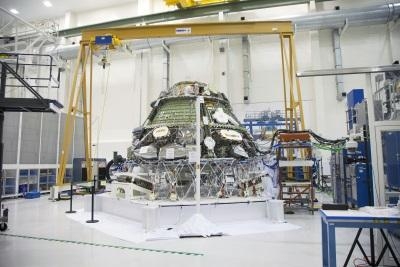Marks Another Milestone Towards Initial Unmanned Test Flight
Testing designed to simulate the vibrations NASA's Orion will experience during its first trip to space successfully wrapped up inside the Operations and Checkout Building high bay at NASA's Kennedy Space Center in Florida. The completion of the testing marks another step forward toward Orion's uncrewed December flight that will put to the test the spacecraft that will send astronauts to an asteroid and eventually Mars on future missions.

"It was a great accomplishment for the test team in preparation for the Exploration Flight Test-1 later this year," said Rafael Garcia, the Orion Program Test and Verification lead at NASA's Johnson Space Center in Houston. "Following months of preparations and pretest analysis, the multi-point random vibration test was conducted without any major issues and was completed two days ahead of schedule."
To prepare for the vibration tests, which were conducted April 17-24, a team of NASA and Lockheed Martin engineers and technicians transferred Orion from the crew module assembly station to a special vibration stand in a portable test chamber. The spacecraft was isolated from the floor and stand on special footing. Orion's thrusters were cantilevered out so they were isolated from the test, and its windows, parachutes and drogue chutes were covered for protection.
Accelerometers and strain gages were placed around the crew module in various locations. These were used to measure simulated acceleration and strain levels on Orion's structure.
Two electromagnetic shakers, each capable of up to 4,000 pounds of force, were attached to Orion on opposite sides. Baseline vibration tests began at five megahertz and gradually were increased up to about 500 megahertz. After each test run, the shakers were relocated to different points on Orion and systems specialists checked for any changes or abnormalities in the spacecraft's structure.
Garcia said that preliminary analysis of the test data confirmed that Orion's structure performed as predicted. Before each thirty-second test run, Orion's avionics, batteries and electrical systems were powered up and its ammonia and helium tanks were pressurized to 200 psi.
The tests were monitored in a separate control room near the high bay, and the data after each 30-second run was analyzed to check for imperfections or defects and how the crew module performed. A flight following team in Firing Room 1 in Kennedy's Launch Control Center monitored Orion during periods of powered-up testing. "Shut-down limits were established in case the vibrations began to exceed limits," said Trevor Kott, the Orion Crew and Service Module ground test manager at Johnson. "This kind of test can be very complicated. There's a science to finding the right balance."
During the vibration test, other instrumentation on Orion was monitored for its state of health. "The completion of the test is a great accomplishment for the test team and NASA's Orion Program in preparation for EFT-1," Garcia said.
(Image provided by NASA)
 ANN's Daily Aero-Term (04.25.24): Airport Rotating Beacon
ANN's Daily Aero-Term (04.25.24): Airport Rotating Beacon ANN's Daily Aero-Linx (04.25.24)
ANN's Daily Aero-Linx (04.25.24) Klyde Morris (04.22.24)
Klyde Morris (04.22.24) Airborne 04.24.24: INTEGRAL E, Elixir USA, M700 RVSM
Airborne 04.24.24: INTEGRAL E, Elixir USA, M700 RVSM Airborne 04.22.24: Rotor X Worsens, Airport Fees 4 FNB?, USMC Drone Pilot
Airborne 04.22.24: Rotor X Worsens, Airport Fees 4 FNB?, USMC Drone Pilot



